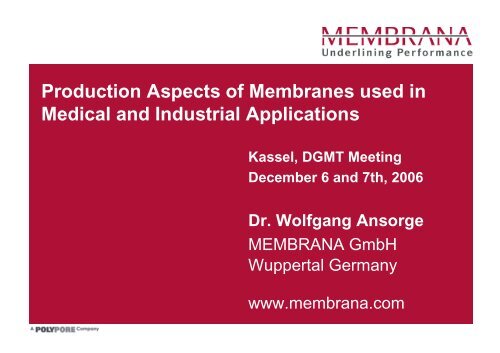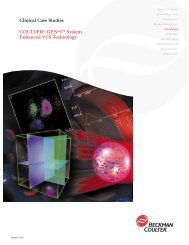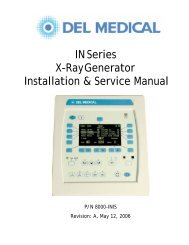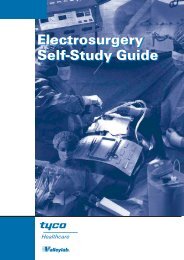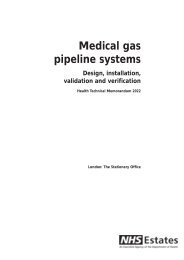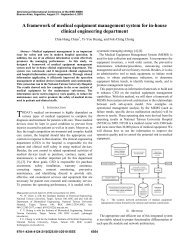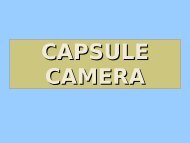Production Aspects of Membranes used in Medical and Industrial ...
Production Aspects of Membranes used in Medical and Industrial ...
Production Aspects of Membranes used in Medical and Industrial ...
You also want an ePaper? Increase the reach of your titles
YUMPU automatically turns print PDFs into web optimized ePapers that Google loves.
<strong>Production</strong> <strong>Aspects</strong> <strong>of</strong> <strong>Membranes</strong> <strong>used</strong> <strong>in</strong><br />
<strong>Medical</strong> <strong>and</strong> <strong>Industrial</strong> Applications<br />
Kassel, DGMT Meet<strong>in</strong>g<br />
December 6 <strong>and</strong> 7th, 2006<br />
Dr. Wolfgang Ansorge<br />
MEMBRANA GmbH<br />
Wuppertal Germany<br />
www.membrana.com
<strong>Production</strong> <strong>Aspects</strong> <strong>of</strong> <strong>Membranes</strong><br />
Content <strong>of</strong> Presentation / Outl<strong>in</strong>e<br />
� Goal <strong>of</strong> Presentation<br />
�Historical Background<br />
�Markets<br />
�Polymers <strong>and</strong> Solvents for <strong>Membranes</strong><br />
�Membrane Formation (SIPS <strong>and</strong> TIPS)<br />
�Poduction Processes<br />
�Typical Applications<br />
�Required Membrane Properties <strong>and</strong> Influence <strong>of</strong> <strong>Production</strong><br />
Parameters<br />
�Modules<br />
� Summary
<strong>Production</strong> <strong>Aspects</strong> <strong>of</strong> <strong>Membranes</strong><br />
Goal <strong>of</strong> Presentation<br />
� Give a short historical overview <strong>and</strong> describe the market<br />
situation.<br />
� Provide an overview <strong>in</strong>sight <strong>of</strong> membrane formation<br />
mechanisms <strong>and</strong> subsequent consequences for materials<br />
<strong>used</strong> <strong>in</strong> membrane production <strong>and</strong> <strong>in</strong> the respective<br />
production processes.<br />
� Discuss some examples <strong>of</strong> membranes for medical <strong>and</strong><br />
<strong>in</strong>dustrial applications <strong>and</strong> the <strong>in</strong>fluence <strong>of</strong> the production<br />
processes on performance parameters.<br />
� Make a short side step to module manufactur<strong>in</strong>g.
<strong>Production</strong> <strong>Aspects</strong> <strong>of</strong> <strong>Membranes</strong><br />
Historical Background <strong>and</strong><br />
Markets
<strong>Production</strong> <strong>Aspects</strong> <strong>of</strong> <strong>Membranes</strong><br />
Membrana´s History<br />
start <strong>of</strong> CUPROPHAN ® capillary membrane<br />
start <strong>of</strong> dialysis membrane production<br />
start <strong>of</strong> CUPROPHAN ® production<br />
1920-40 major manufacturer <strong>of</strong><br />
“artificial silk”, worldwide<br />
famous artificial<br />
“Bemberg silk”<br />
”turkish red”<br />
dye<strong>in</strong>g company<br />
1792<br />
start <strong>of</strong> <strong>in</strong>dustrial membrane production<br />
(ACCUREL ® )<br />
1917<br />
<strong>in</strong>troduction <strong>of</strong> DIAPES ® <strong>and</strong> OXYPLUS ®<br />
start <strong>of</strong> SMC ® - <strong>and</strong> MicroPES ® membrane production 1995<br />
<strong>in</strong>troduction <strong>of</strong> HEMOPHAN ® <strong>and</strong> OXYPHAN ®<br />
1920<br />
1945<br />
1965<br />
1974<br />
1980<br />
Enka AG 1977<br />
Enka Glanzst<strong>of</strong>f AG 1972<br />
1988<br />
1999/2000<br />
Glanzst<strong>of</strong>f AG merged withVere<strong>in</strong>igten Glanzst<strong>of</strong>f Fabriken 1971<br />
J. P. Bemberg (major shareholder Vere<strong>in</strong>igte Glanzst<strong>of</strong>f Fabriken) 1925<br />
J.P. Bemberg 1792, ab 1900 J. P. Bemberg AG<br />
Forward <strong>in</strong>tegration module manufactur<strong>in</strong>g<br />
<strong>in</strong>troduction <strong>of</strong> PUREMA ®<br />
<strong>in</strong>troduction <strong>of</strong> DURAPES<br />
2004<br />
® <strong>and</strong> MicrolonTM <strong>in</strong>troduction <strong>of</strong> Liqui-Flux ®<br />
2006<br />
2005<br />
<strong>in</strong>troduction <strong>of</strong> HEXPET ® 2000<br />
Enka AG / Akzo 1988<br />
Acordis 1999<br />
Akzo Nobel Faser AG 1994<br />
Akzo Faser AG 1991<br />
Membrana GmbH,<br />
Polypore 2002
<strong>Production</strong> <strong>Aspects</strong> <strong>of</strong> <strong>Membranes</strong><br />
Markets / Development <strong>of</strong> Dialyzers by Regions<br />
Mill Pcs<br />
200<br />
150<br />
100<br />
50<br />
0<br />
ROW<br />
W-Europe<br />
Japan<br />
NA<br />
23<br />
24<br />
30<br />
15<br />
+ 9%/a<br />
38<br />
31<br />
38<br />
35<br />
+ 7%/a<br />
2000 2005 2010E<br />
60<br />
39<br />
46<br />
54
<strong>Production</strong> <strong>Aspects</strong> <strong>of</strong> <strong>Membranes</strong><br />
Markets / Oxygenations – Procedures: Potential<br />
<strong>in</strong> 1,000<br />
1.400<br />
1.200<br />
1.000<br />
800<br />
600<br />
400<br />
200<br />
0<br />
1999 2000 2001 2002 2003 2004 2005 2006 2007 2008 2009<br />
ROW<br />
Japan<br />
USA<br />
Europa
<strong>Production</strong> <strong>Aspects</strong> <strong>of</strong> <strong>Membranes</strong><br />
Markets / US-Membrane Systems Dem<strong>and</strong> MF <strong>and</strong> UF<br />
Adapted from: The Freedonia Group, Membrane Sep. Technologies, market report, Dec. 2003
<strong>Production</strong> <strong>Aspects</strong> <strong>of</strong> <strong>Membranes</strong><br />
Polymers <strong>and</strong> Solvents
<strong>Production</strong> <strong>Aspects</strong> <strong>of</strong> <strong>Membranes</strong><br />
Polymers / What is the Desired Membrane Design?<br />
� Appearance (hollow fiber, tube, flat sheet)<br />
� Permeability <strong>and</strong> selectivity to the desired solutes<br />
� Adequate siev<strong>in</strong>g characteristics (cut <strong>of</strong>fs)<br />
� Adequate water (or solvent) permeability<br />
� Chemical <strong>and</strong> physical resistance (pH, peroxides, acids,<br />
caustics, blood)<br />
� Low amounts <strong>of</strong> extractables (TOC, toxicity)<br />
� Heat resistance (sterilizeability)<br />
� Impermeability <strong>of</strong> bacteria / viruses (pharmaceutical appl.)
<strong>Production</strong> <strong>Aspects</strong> <strong>of</strong> <strong>Membranes</strong><br />
Polymers / How to choose the Membrane Material?<br />
� Membrane form<strong>in</strong>g properties (mol weight distribution)<br />
� Solubility <strong>in</strong> commonly <strong>used</strong> solvents<br />
� Storage stability <strong>of</strong> the sp<strong>in</strong>n<strong>in</strong>g solution<br />
� Costs<br />
� Chemical structure with respect to<br />
�chemical stability (solvents <strong>and</strong> solutes <strong>used</strong> <strong>in</strong> the application)<br />
�physical stability (tensile strength, elongation at break)<br />
�hydrophilicity / hydrophobicity (wettability)<br />
�adsorptive properties aga<strong>in</strong>st solutes (foul<strong>in</strong>g)<br />
�extractable monomers or oligomers (TOC, toxicity)<br />
�stability aga<strong>in</strong>st oxidation (discolouration, sterilization)<br />
�stability aga<strong>in</strong>st heat / steam (temp. <strong>in</strong> application, sterilization)<br />
�bio- / hemocompatibility (prote<strong>in</strong> adsorption, cell stimulation)<br />
�make-up (w<strong>in</strong>d<strong>in</strong>g, pott<strong>in</strong>g, cutt<strong>in</strong>g, module design)
<strong>Production</strong> <strong>Aspects</strong> <strong>of</strong> <strong>Membranes</strong><br />
Polymers / Typical Raw Materials<br />
� Dialysis<br />
� Cellulose / Modified Cellulose (DEAE, Benzyl) (Semi synthetic)<br />
� Cellulose Acetate (CA or CTA)<br />
� Polycarbonate (PC)<br />
� Polyacrylonitrile (PAN)<br />
� Polyamide (PA)<br />
� Polysulfone (PSu)<br />
� Polyethersulfone (PES)<br />
� Oxygenation<br />
� Polypropylene (PP)<br />
� Polyethylene (PE)<br />
� Polymethylpentene (PMP)<br />
� Plasma Treatment<br />
� Polypropylene (PP)<br />
� Polyethersulfone (PES)<br />
� Poly-(ethylene-v<strong>in</strong>ylalcohol) (EVAL)<br />
� Others<br />
(<strong>Industrial</strong> applications or l<strong>in</strong>ked to Medic<strong>in</strong>e)<br />
� Polyolef<strong>in</strong>s (PP, PE, PMP)<br />
� Polyethersulfone (PES)<br />
� Polyamides (PA 6, PA 6.6)<br />
� Polysulfone (PSu)<br />
� Cellulose Acetate (CA)<br />
� Polyv<strong>in</strong>ylidenefluoride (PVDF)<br />
� Polytetrafuoroethylene (PTFE)<br />
� Polyimides (PI)<br />
� Polyetherimides (PEI)<br />
� Polyetheretherketones (PEEK)<br />
� Silicones
<strong>Production</strong> <strong>Aspects</strong> <strong>of</strong> <strong>Membranes</strong><br />
Solvents / How to Choose the Right System?<br />
� Availability<br />
� Polymer solubility properties (solution stability)<br />
� Toxicity (safe h<strong>and</strong>l<strong>in</strong>g � workers, extractables � patient <strong>and</strong> TOC)<br />
� Costs (price <strong>of</strong> f<strong>in</strong>al product)<br />
� Recovery (ability, procedure � costs)<br />
� Environmental aspects (waste water)<br />
� Chemical structure with respect to<br />
�thermal stability<br />
�oxidative stability<br />
�explosion safeness<br />
�melt<strong>in</strong>g <strong>and</strong> boil<strong>in</strong>g po<strong>in</strong>ts<br />
�vapour pressure<br />
�<strong>in</strong>ertness (no reaction with polymer or other igredients <strong>of</strong> sp<strong>in</strong>n<strong>in</strong>g solution)<br />
�miscibility with e.g. water or alcohols (extraction media)<br />
Remark: Not all properties may be fulfilled by a solvent (system)
<strong>Production</strong> <strong>Aspects</strong> <strong>of</strong> <strong>Membranes</strong><br />
Solvents / Typical Systems<br />
� Solvents<br />
�Cuoxam (ammonia, caustic copper sulfate, sodium hydroxide)<br />
�Aprotic liquids (DMSO, DMF, DMAc, NMP)<br />
�Alcohols (methanol, ethanol, IPA or others)<br />
�Lactones, Lactams<br />
�Chlor<strong>in</strong>ated hydrocarbons (methylene-chloride etc.)<br />
�Oils (soy bean oil, castor oil, others)<br />
�Ethers (THF, others)<br />
� Additives<br />
�PVP, PEGs (poreformers, hydrophiliz<strong>in</strong>g agents, <strong>in</strong>creased viscosity)<br />
�Glycerol (pore conservation)<br />
�Other polymers (blend<strong>in</strong>g)<br />
�Stabilizers (antioxidants, protection aga<strong>in</strong>st discolouration, heat protection)
<strong>Production</strong> <strong>Aspects</strong> <strong>of</strong> <strong>Membranes</strong><br />
Membrane Formation
<strong>Production</strong> <strong>Aspects</strong> <strong>of</strong> <strong>Membranes</strong><br />
Membrane Formation / Mechanism <strong>of</strong> Phase<br />
Separation (SIPS)<br />
Path A<br />
metastable condition<br />
NG (nucleation growth)<br />
100<br />
0<br />
solvent<br />
A<br />
Polymer<br />
0<br />
100<br />
B<br />
0<br />
100<br />
non-solvent<br />
Path B<br />
unstable condition<br />
SD (sp<strong>in</strong>odal decomposition)<br />
Slow (controlled) precipitation Quick (uncontrolled) precipitation<br />
Adapted from: Membranen: Grundlagen, Verfahren und <strong>in</strong>d. Anwendung, K. Ohlrogge und K. Ebert, Wiley 2006
<strong>Production</strong> <strong>Aspects</strong> <strong>of</strong> <strong>Membranes</strong><br />
Membrane Formation / Solvent Induced Phase<br />
Separation (SIPS)<br />
Pr<strong>in</strong>ciple<br />
Melted<br />
mass<br />
Capillary<br />
membrane<br />
Core liquid<br />
Polymer<br />
Sp<strong>in</strong>n<strong>in</strong>g / Cast<strong>in</strong>g Solution<br />
Sp<strong>in</strong>n<strong>in</strong>g<br />
Filtration<br />
Phase separation<br />
(formation <strong>of</strong> membrane)<br />
Wash<strong>in</strong>g/Extraction<br />
Dry<strong>in</strong>g<br />
Process<strong>in</strong>g for shipment<br />
Solvent /<br />
Additives<br />
Cast<strong>in</strong>g<br />
(flat sheet)<br />
Melted mass<br />
Flat<br />
membrane
<strong>Production</strong> <strong>Aspects</strong> <strong>of</strong> <strong>Membranes</strong><br />
Membrane Formation / Mechanism <strong>of</strong> TIPS Process<br />
Nucleation <strong>and</strong> Growth<br />
At low cool<strong>in</strong>g rates<br />
Temperature<br />
Cool<strong>in</strong>g<br />
Polymer concentration<br />
Sp<strong>in</strong>odal Decomposition<br />
At high cool<strong>in</strong>g rates
<strong>Production</strong> <strong>Aspects</strong> <strong>of</strong> <strong>Membranes</strong><br />
<strong>Production</strong> Processes
<strong>Production</strong> <strong>Aspects</strong> <strong>of</strong> <strong>Membranes</strong><br />
<strong>Production</strong> Processes / PES Sp<strong>in</strong>n<strong>in</strong>g Process (SIPS)<br />
Modular concept for DIAPES ® , PUREMA ® , MicroPES ® <strong>and</strong> UltraPES<br />
Polymer<br />
solution<br />
Bore<br />
liquid<br />
Sp<strong>in</strong>neret<br />
coagulation pre-extraction<br />
Cross-section view<br />
Polymer sp<strong>in</strong>n<strong>in</strong>g<br />
solution<br />
make-up<br />
• dry<strong>in</strong>g<br />
• w<strong>in</strong>d<strong>in</strong>g<br />
• cutt<strong>in</strong>g<br />
Bore liquid<br />
wrapp<strong>in</strong>g<br />
pipel<strong>in</strong>e<br />
air<br />
water<br />
extraction<br />
&<br />
dry<strong>in</strong>g
<strong>Production</strong> <strong>Aspects</strong> <strong>of</strong> <strong>Membranes</strong><br />
<strong>Production</strong> Processes / PES<br />
Partial view <strong>of</strong> the plant
<strong>Production</strong> <strong>Aspects</strong> <strong>of</strong> <strong>Membranes</strong><br />
<strong>Production</strong> Processes / DIAPES ® Membrane Structure<br />
Scann<strong>in</strong>g Electron Microscopy<br />
= 5 nm<br />
= 100 nm<br />
30 µm<br />
= 10 nm
<strong>Production</strong> <strong>Aspects</strong> <strong>of</strong> <strong>Membranes</strong><br />
<strong>Production</strong> Processes / UltraPES Membrane Structure<br />
Scann<strong>in</strong>g Electron Microscopy<br />
Function:<br />
Poresize<br />
about:<br />
Separation<br />
Layer<br />
220 µm<br />
Support Layer Protection<br />
Layer<br />
6 – 7 nm Up to 500 nm 20 - 100 nm
<strong>Production</strong> <strong>Aspects</strong> <strong>of</strong> <strong>Membranes</strong><br />
<strong>Production</strong> Processes / Flat Membrane Cast<strong>in</strong>g<br />
(SIPS)<br />
Polymer<br />
solution<br />
Climate box<br />
Cast<strong>in</strong>g unit<br />
Chill roll<br />
Precipitation Wash<strong>in</strong>g<br />
stretch<strong>in</strong>g<br />
relaxation<br />
post<br />
treatment<br />
control <strong>of</strong><br />
<strong>in</strong>tegrity <strong>and</strong><br />
dimensions<br />
optional<br />
Roll<br />
•Dry<strong>in</strong>g<br />
•W<strong>in</strong>d<strong>in</strong>g<br />
•Cutt<strong>in</strong>g
<strong>Production</strong> <strong>Aspects</strong> <strong>of</strong> <strong>Membranes</strong><br />
<strong>Production</strong> Processes / PES Flat-Membrane Structures<br />
Scann<strong>in</strong>g Electron Microscopy<br />
MicroPES ® 2F<br />
DuraPES ® 200<br />
Asymmetrical structure<br />
Very asymmetrical structure<br />
Chill Roll Side Air Side Cross Section
<strong>Production</strong> <strong>Aspects</strong> <strong>of</strong> <strong>Membranes</strong><br />
<strong>Production</strong> Processes / Flux Comparison<br />
<strong>Membranes</strong> out <strong>of</strong> SIPS Process<br />
Nom<strong>in</strong>al pore size (µm)<br />
1,6<br />
1,4<br />
1,2<br />
1<br />
0,8<br />
0,6<br />
0,4<br />
0,2<br />
For DuraPES ® fluxes are higher than for comparable MicroPES ® types<br />
UltraPES ®<br />
DIAPES ® HF<br />
FractioPES ®<br />
MicroPES ® 1F PH<br />
MicroPES ® MicroPES<br />
2F<br />
® MicroPES<br />
4F<br />
® MicroPES 6F<br />
® 0.3/2<br />
DuraPES ® DuraPES<br />
200<br />
® DuraPES<br />
450<br />
® 600<br />
0<br />
102 103 105 104 > 500<br />
MicroPES ® 12F<br />
log hydraulic permeability - water [ml / (h x m² x mmHg)]<br />
> 500 ml / h m² mmHg = > 0,65 ml / m<strong>in</strong> cm² bar<br />
= Technical Products („F“ represents Flat <strong>Membranes</strong>)<br />
= <strong>Medical</strong> Products (for comparison)<br />
10 6
<strong>Production</strong> <strong>Aspects</strong> <strong>of</strong> <strong>Membranes</strong><br />
<strong>Production</strong> Processes / Process Scheme (TIPS)<br />
Polymer Solvent<br />
Heat<br />
Temperature<br />
controlled air gap<br />
Gas N 2<br />
Heated<br />
extruder<br />
Or sp<strong>in</strong>n<strong>in</strong>g bar <strong>and</strong> chill roll<br />
<strong>in</strong>stead <strong>of</strong> sp<strong>in</strong>neret<br />
No gas needed<br />
Sp<strong>in</strong>neret<br />
Gas Melted polymer<br />
<strong>and</strong> high<br />
temperature<br />
solvent<br />
1. sp<strong>in</strong>n<strong>in</strong>g 2. extraction 3. dry<strong>in</strong>g <strong>and</strong> w<strong>in</strong>d<strong>in</strong>g
<strong>Production</strong> <strong>Aspects</strong> <strong>of</strong> <strong>Membranes</strong><br />
<strong>Production</strong> Processes / SEM <strong>of</strong> OXYPHAN ® (PP)<br />
Inner surface Cross section Outer surface
<strong>Production</strong> <strong>Aspects</strong> <strong>of</strong> <strong>Membranes</strong><br />
<strong>Production</strong> Processes / Flat Membrane Cast<strong>in</strong>g<br />
(Mixed TIPS <strong>and</strong> SIPS)<br />
Polymer<br />
Dosage<br />
Heated<br />
extruder<br />
Solvent<br />
Mixer<br />
Precipitation Wash<strong>in</strong>g<br />
So called „solution mach<strong>in</strong>e“<br />
Cast<strong>in</strong>g unit (heated)<br />
Chill roll (controlled cool<strong>in</strong>g)<br />
stretch<strong>in</strong>g<br />
relaxation<br />
post<br />
treatment<br />
control <strong>of</strong><br />
<strong>in</strong>tegrity <strong>and</strong><br />
dimensions<br />
optional<br />
Roll<br />
•Dry<strong>in</strong>g<br />
•W<strong>in</strong>d<strong>in</strong>g<br />
•Cutt<strong>in</strong>g
<strong>Production</strong> <strong>Aspects</strong> <strong>of</strong> <strong>Membranes</strong><br />
<strong>Production</strong> Processes / Typical SEM (PA)<br />
Chill roll side Air side<br />
Mag. 5000<br />
Smaller but<br />
more pores<br />
Cross section<br />
Mag. 5000<br />
Larger but<br />
less pores<br />
Mag. 500<br />
More or less symmetrical
<strong>Production</strong> <strong>Aspects</strong> <strong>of</strong> <strong>Membranes</strong><br />
<strong>Production</strong> Processes / Melt Extrusion <strong>and</strong> Stretch<strong>in</strong>g<br />
(CELGARD ® )<br />
Scheme Melt Extrusion<br />
Polymer<br />
Dosage<br />
Heated<br />
extruder<br />
Air Cool<strong>in</strong>g<br />
Die<br />
Filter<br />
Spool<br />
W<strong>in</strong>d<strong>in</strong>g <strong>of</strong> non porous<br />
capillary
<strong>Production</strong> <strong>Aspects</strong> <strong>of</strong> <strong>Membranes</strong><br />
<strong>Production</strong> Processes / Melt Extrusion <strong>and</strong> Stretch<strong>in</strong>g<br />
(CELGARD ® )<br />
Scheme Stretch<strong>in</strong>g<br />
Spool<br />
Anneal<br />
Non porous capillary<br />
Cold Stretch<br />
Hot Stretch<br />
Spool<br />
Porous capillary
<strong>Production</strong> <strong>Aspects</strong> <strong>of</strong> <strong>Membranes</strong><br />
<strong>Production</strong> Processes / CELGARD ® - Extruder<br />
“Precursor Precursor Spool” Spool
<strong>Production</strong> <strong>Aspects</strong> <strong>of</strong> <strong>Membranes</strong><br />
<strong>Production</strong> Processes / CELGARD ® X30-240 HFM<br />
Celgard X30-240<br />
typical values<br />
Thickness 28 µ<br />
Gurley 35 sec<br />
Porosity 40%<br />
Shr<strong>in</strong>kage 2.5 %<br />
Pore size 0.03 x 0.6 µm
<strong>Production</strong> <strong>Aspects</strong> <strong>of</strong> <strong>Membranes</strong><br />
Typical <strong>Medical</strong> Applications
<strong>Production</strong> <strong>Aspects</strong> <strong>of</strong> <strong>Membranes</strong><br />
Typical <strong>Medical</strong> Applications / Hemodialysis<br />
Blood<br />
>200ml/m<strong>in</strong><br />
Capillary<br />
membranes<br />
Dialysate Blood<br />
Dialyzer<br />
500ml/m<strong>in</strong><br />
Dialysate + ultrafiltrate<br />
>500ml/m<strong>in</strong><br />
Dialysate<br />
to waste
<strong>Production</strong> <strong>Aspects</strong> <strong>of</strong> <strong>Membranes</strong><br />
Typical <strong>Medical</strong> Applications / Oxygenation<br />
dra<strong>in</strong><strong>in</strong>g l<strong>in</strong>es<br />
cardiotomy<br />
arterial<br />
filter<br />
blood (3-6l/m<strong>in</strong>)<br />
oxygenator<br />
O 2 + CO 2<br />
O 2
<strong>Production</strong> <strong>Aspects</strong> <strong>of</strong> <strong>Membranes</strong><br />
Typical <strong>Medical</strong> Application / Plasmaseparation<br />
filtered<br />
plasma<br />
blood<br />
>200ml/m<strong>in</strong><br />
capillary<br />
membranes<br />
blood<br />
plasma<br />
filter<br />
about 40ml/m<strong>in</strong><br />
removed<br />
replacement by plasma plasma<br />
<strong>of</strong> healthy donors<br />
(therapeutic plasmapheresis)
<strong>Production</strong> <strong>Aspects</strong> <strong>of</strong> <strong>Membranes</strong><br />
Required Membrane Properties
<strong>Production</strong> <strong>Aspects</strong> <strong>of</strong> <strong>Membranes</strong><br />
Required Membrane Properties / Hemodialysis<br />
Blood UFR<br />
ml/hm²mmHg<br />
Flux <strong>and</strong> Siev<strong>in</strong>g Coefficients<br />
LF<br />
PUREMA ®<br />
L<br />
LF+<br />
DIAPES ®<br />
LF100<br />
HP<br />
DIAPES ®<br />
HP200<br />
DIAPES ®<br />
HF800XP<br />
Synthetic Dialysis <strong>Membranes</strong> (PES)<br />
HF<br />
6 10 - 12 15 - 20 > 30<br />
PUREMA ®<br />
H<br />
DIAPES ®<br />
HF800<br />
Remark: Increased siev<strong>in</strong>g coefficients also implement <strong>in</strong>creased ß2-M clearances / siev<strong>in</strong>g coefficient
<strong>Production</strong> <strong>Aspects</strong> <strong>of</strong> <strong>Membranes</strong><br />
Required Membrane Properties / Hemodialysis<br />
S.E.T. – Siev<strong>in</strong>g Enhanc<strong>in</strong>g Technology<br />
%<br />
Vit. B12: 2,88 nm<br />
Inul<strong>in</strong>:4,60 nm<br />
ß2-m: 5,94 nm<br />
pore size<br />
α1−m: 8,28 nm<br />
BSA:10,64 nm<br />
PUREMA H<br />
Fresenius FX<br />
Polyflux S<br />
PUREMA ®<br />
Conventional Polysulfone
<strong>Production</strong> <strong>Aspects</strong> <strong>of</strong> <strong>Membranes</strong><br />
Required Membrane Properties / Hemodialysis<br />
PUREMA ® : Active Surface Management<br />
Red: hydrophobic surface (PES)<br />
Green: hydrophilic surface (PVP)<br />
Blue dots: active centers<br />
Blue circles: mediation <strong>of</strong> the<br />
<strong>in</strong>teractions <strong>of</strong> tox<strong>in</strong>s <strong>and</strong><br />
prote<strong>in</strong>s across the whole <strong>in</strong>ner<br />
surface
<strong>Production</strong> <strong>Aspects</strong> <strong>of</strong> <strong>Membranes</strong><br />
Required Membrane Properties / Hemodialysis<br />
Pr<strong>in</strong>ciple <strong>of</strong> P.E.T. ® - Performence Enhanc<strong>in</strong>g Technology<br />
Membrane capillaries, specially comb<strong>in</strong>ed with<br />
multifilament yarn<br />
Remark: Improved low molecular weight clearance by<br />
optimized dialysate flow
<strong>Production</strong> <strong>Aspects</strong> <strong>of</strong> <strong>Membranes</strong><br />
Required Membrane Properties / Hemodialysis<br />
Pr<strong>in</strong>ciple <strong>of</strong> P.E.T. ® : Clearance Improvement<br />
Clearance (ml/m<strong>in</strong>)<br />
350<br />
300<br />
250<br />
200<br />
150<br />
+ 7.1%<br />
+ 6.7%<br />
DIAPES (1.7m²) without P.E.T.<br />
DIAPES (1.7m²) with P.E.T.<br />
+ 7.4%<br />
Q B = 400ml/m<strong>in</strong><br />
Q D = 500ml/m<strong>in</strong><br />
Q F = 10 ml/m<strong>in</strong><br />
+ 6.6%<br />
Urea Creat<strong>in</strong><strong>in</strong>e Phosphate Vit B12
<strong>Production</strong> <strong>Aspects</strong> <strong>of</strong> <strong>Membranes</strong><br />
Required Membrane Properties / Oxygenation<br />
� O 2 <strong>and</strong> CO 2 transfer rates <strong>in</strong>fluenced by pore structure<br />
(� TIPS – process)<br />
� Plasma breakthrough <strong>in</strong>fluenced by hydrophobicity <strong>of</strong><br />
polymer (PP or PMP) <strong>and</strong> membrane structure<br />
(sk<strong>in</strong> � PMP)<br />
� Hydrodynamics <strong>of</strong> blood flow <strong>in</strong>fluenced by membrane<br />
make-up<br />
(� mat formation)
<strong>Production</strong> <strong>Aspects</strong> <strong>of</strong> <strong>Membranes</strong><br />
Required Membrane Properties / Oxygenation<br />
Mat formation to optimize hydrodynamics <strong>of</strong> blood flow<br />
Polyester warp thread<br />
100 % visual <strong>in</strong>spection<br />
Cross-wound mat
<strong>Production</strong> <strong>Aspects</strong> <strong>of</strong> <strong>Membranes</strong><br />
Required Membrane Properties / Plasmatreatment<br />
� High plasma flux<br />
(� surface porosity <strong>and</strong> pore size)<br />
� Appropriate <strong>in</strong>ner diameter<br />
(� optimal hydrodynamics)<br />
� Smooth surface<br />
(� no damage <strong>of</strong> cells)
<strong>Production</strong> <strong>Aspects</strong> <strong>of</strong> <strong>Membranes</strong><br />
<strong>Industrial</strong> Applications
<strong>Production</strong> <strong>Aspects</strong> <strong>of</strong> <strong>Membranes</strong><br />
Selection <strong>of</strong> Typical <strong>Industrial</strong> Applications<br />
<strong>Membranes</strong>: e.g. MicroPES ® , DuraPES ® , UltraPES, Celgard ®<br />
� Filtration <strong>of</strong> liquids<br />
� water, w<strong>in</strong>e, beer, milk, fruit juices<br />
�prefiltration or f<strong>in</strong>al filtration with different pore sizes<br />
� >1 µm down to 0.05 µm <strong>in</strong> Micr<strong>of</strong>iltration<br />
� cut-<strong>of</strong>f 50 – 150 kD <strong>in</strong> Ultrafiltration<br />
� cut-<strong>of</strong>f < 50 kD <strong>in</strong> Nan<strong>of</strong>iltration<br />
� Sterile filtration <strong>in</strong> pharmaceutical processes � ultraclean water<br />
� nom<strong>in</strong>al pore size 0,2 µm (Micr<strong>of</strong>iltration) � retention <strong>of</strong> pseudomonas dim<strong>in</strong>utas<br />
� mechanical stability � manufactur<strong>in</strong>g <strong>of</strong> pleated cartridges<br />
� high porosity � high water fluxes<br />
� low adsorption � high service life<br />
� second filtration step: Ultrafiltration � modules with capillaries<br />
� last step: Reverse Osmosis<br />
� Endotox<strong>in</strong> filters � ultraclean dialysate <strong>in</strong> cl<strong>in</strong>ics<br />
� high porosity � high water fluxes<br />
� adsorption <strong>of</strong> endotox<strong>in</strong>s � safety, no breakthrough<br />
� Oil / water separation<br />
� Degass<strong>in</strong>g<br />
Typical polymers: PSu, PES, PP, CA, PVDF, PTFE<br />
Many other applications not mentioned
<strong>Production</strong> <strong>Aspects</strong> <strong>of</strong> <strong>Membranes</strong><br />
Selection <strong>of</strong> Typical <strong>Industrial</strong> Applications<br />
Typical Pharmaceutical UPW system<br />
Multimedia<br />
filtration RO<br />
Po<strong>in</strong>ts<br />
<strong>of</strong> Use<br />
Reclaim<br />
Water<br />
Reclaim<br />
Tank<br />
Membrane<br />
Deaerator<br />
CO2<br />
Removal<br />
UV<br />
Micr<strong>of</strong>iltration<br />
Ultrafiltration<br />
Polish<strong>in</strong>g<br />
Bed<br />
Recycle<br />
UV<br />
UV<br />
Micr<strong>of</strong>iltration<br />
DI Beds<br />
Membrane<br />
Degasifier<br />
Dissolved O2 &<br />
N2 Removal<br />
UV<br />
Ultrafiltration<br />
Mixed<br />
Bed<br />
Storage<br />
Tank<br />
Ozonation
<strong>Production</strong> <strong>Aspects</strong> <strong>of</strong> <strong>Membranes</strong><br />
Module Manufactur<strong>in</strong>g
<strong>Production</strong> <strong>Aspects</strong> <strong>of</strong> <strong>Membranes</strong><br />
Module Manufactur<strong>in</strong>g / Requirements<br />
�Hous<strong>in</strong>g<br />
- stability aga<strong>in</strong>st mechanical stress, heat, pressure, chemicals <strong>and</strong><br />
low amount <strong>of</strong> extractables<br />
�Pott<strong>in</strong>g material<br />
- see above <strong>and</strong> additionally good adhesion properties � no leaks<br />
�General construction<br />
- high membrane surface area, flow distribution, exchangeability (complete <strong>and</strong> <strong>of</strong><br />
membrane elements), cleanability
<strong>Production</strong> <strong>Aspects</strong> <strong>of</strong> <strong>Membranes</strong><br />
Module Manufactur<strong>in</strong>g / Examples<br />
Liqui-Cel ® Degasifier with Celgard ®<br />
215 m 2 membrane area<br />
Aqueous<br />
Stream<br />
Aqueous<br />
Stream<br />
Cartridge<br />
Vacuum <strong>and</strong>/or<br />
Strip Gas<br />
Distribution Tube<br />
Hollow fiber Membrane<br />
Baffle<br />
Collection Tube<br />
Hous<strong>in</strong>g<br />
Strip<br />
Gas
<strong>Production</strong> <strong>Aspects</strong> <strong>of</strong> <strong>Membranes</strong><br />
Module Manufactur<strong>in</strong>g / Examples<br />
R<br />
Ultrafiltration module with UltraPES
<strong>Production</strong> <strong>Aspects</strong> <strong>of</strong> <strong>Membranes</strong><br />
Module Manufactur<strong>in</strong>g / Examples<br />
Membrana Module Assortment
<strong>Production</strong> <strong>Aspects</strong> <strong>of</strong> <strong>Membranes</strong><br />
Summary
<strong>Production</strong> <strong>Aspects</strong> <strong>of</strong> <strong>Membranes</strong><br />
Summary<br />
� Polymers <strong>and</strong> solvents have to be chosen accord<strong>in</strong>g to the production<br />
process, costs, environmental aspects <strong>and</strong> determ<strong>in</strong>ed application<br />
� All together these parameters / set-ups are determ<strong>in</strong><strong>in</strong>g the membrane<br />
structure<br />
� Special steps <strong>in</strong> the production like addition <strong>of</strong> additives, polymer<br />
functionalization or <strong>in</strong>telligent make-ups are aid<strong>in</strong>g to <strong>in</strong>crease the<br />
performance <strong>of</strong> membranes or membrane devices<br />
� The needs <strong>of</strong> membrane or membrane device performance are def<strong>in</strong>ed<br />
either by the application or by customer requirements<br />
� Therefore, the membrane manufacturer has to provide a variety <strong>of</strong> all the<br />
items mentioned above<br />
� Module design requires additional know how <strong>and</strong> has to fit to membrane<br />
properties<br />
� Comb<strong>in</strong>ation <strong>of</strong> both areas <strong>of</strong> knowledge <strong>in</strong> one company


